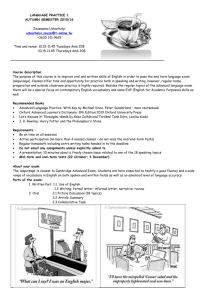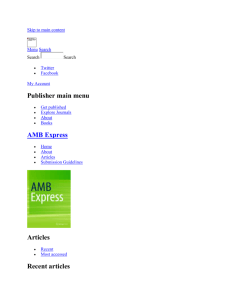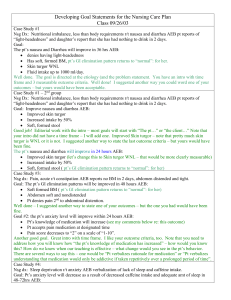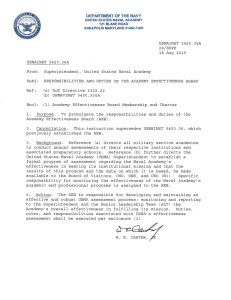MOUNT CARMEL COLLEGE OF NURSING NUTRITION RELATED
advertisement
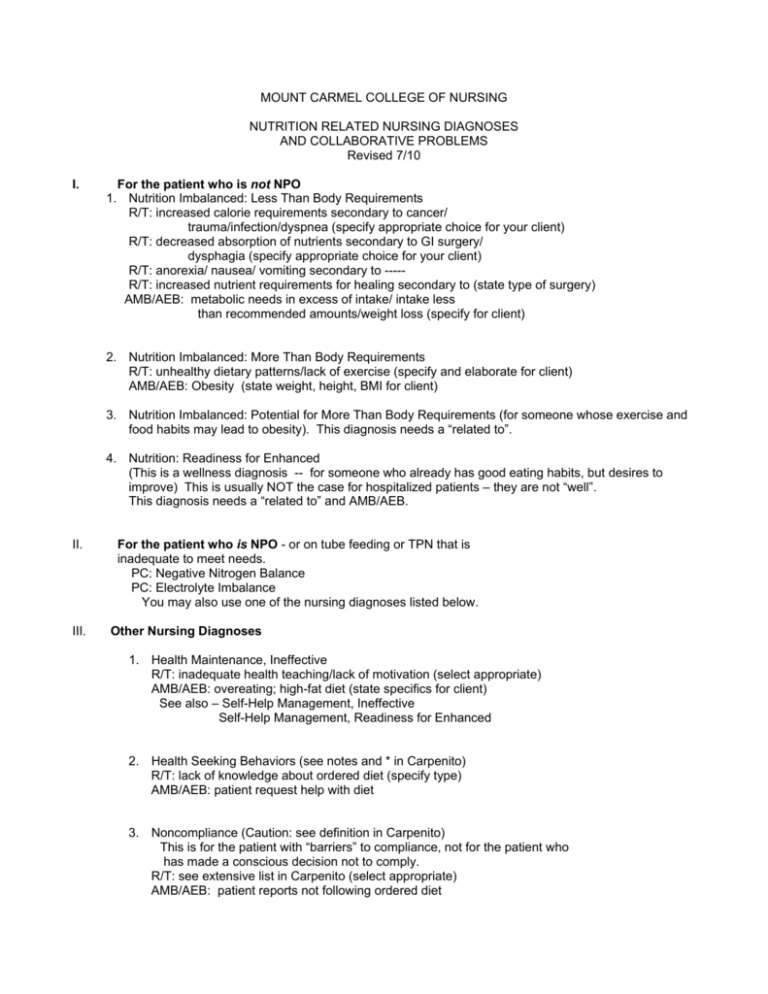
MOUNT CARMEL COLLEGE OF NURSING NUTRITION RELATED NURSING DIAGNOSES AND COLLABORATIVE PROBLEMS Revised 7/10 I. For the patient who is not NPO 1. Nutrition Imbalanced: Less Than Body Requirements R/T: increased calorie requirements secondary to cancer/ trauma/infection/dyspnea (specify appropriate choice for your client) R/T: decreased absorption of nutrients secondary to GI surgery/ dysphagia (specify appropriate choice for your client) R/T: anorexia/ nausea/ vomiting secondary to ----R/T: increased nutrient requirements for healing secondary to (state type of surgery) AMB/AEB: metabolic needs in excess of intake/ intake less than recommended amounts/weight loss (specify for client) 2. Nutrition Imbalanced: More Than Body Requirements R/T: unhealthy dietary patterns/lack of exercise (specify and elaborate for client) AMB/AEB: Obesity (state weight, height, BMI for client) 3. Nutrition Imbalanced: Potential for More Than Body Requirements (for someone whose exercise and food habits may lead to obesity). This diagnosis needs a “related to”. 4. Nutrition: Readiness for Enhanced (This is a wellness diagnosis -- for someone who already has good eating habits, but desires to improve) This is usually NOT the case for hospitalized patients – they are not “well”. This diagnosis needs a “related to” and AMB/AEB. II. III. For the patient who is NPO - or on tube feeding or TPN that is inadequate to meet needs. PC: Negative Nitrogen Balance PC: Electrolyte Imbalance You may also use one of the nursing diagnoses listed below. Other Nursing Diagnoses 1. Health Maintenance, Ineffective R/T: inadequate health teaching/lack of motivation (select appropriate) AMB/AEB: overeating; high-fat diet (state specifics for client) See also – Self-Help Management, Ineffective Self-Help Management, Readiness for Enhanced 2. Health Seeking Behaviors (see notes and * in Carpenito) R/T: lack of knowledge about ordered diet (specify type) AMB/AEB: patient request help with diet 3. Noncompliance (Caution: see definition in Carpenito) This is for the patient with “barriers” to compliance, not for the patient who has made a conscious decision not to comply. R/T: see extensive list in Carpenito (select appropriate) AMB/AEB: patient reports not following ordered diet 4. Diarrhea R/T: malabsorption secondary to disease/medication/surgery (specify) AMB/AEB: loose, liquid stools/frequent stools 5. Constipation R/T: lack of fiber and fluid in diet side effect of medication (specify) decreased metabolic rate secondary to (specify) AMB/AEB: hard, formed stool/infrequent stools 6. Tissue Integrity, Impaired R/T: decreased blood and nutrients to tissues secondary to (specify) R/T: dry, thin skin secondary to aging AMB/AEB: pressure ulcers (list specifics) IV. Other Collaborative Problems 1. Iron-deficiency anemia 2. Hypoglycemia 3. Hyperglycemia 4. Morbid obesity 5. Malnutrition To determine the most appropriate nursing diagnosis or collaborative problem, see Carpenito for definitions and defining characteristics. Note that there are diagnosis statements related to breast feeding and infant feeding. For a complete listing of nursing diagnoses and R/T, see Carpenito.
